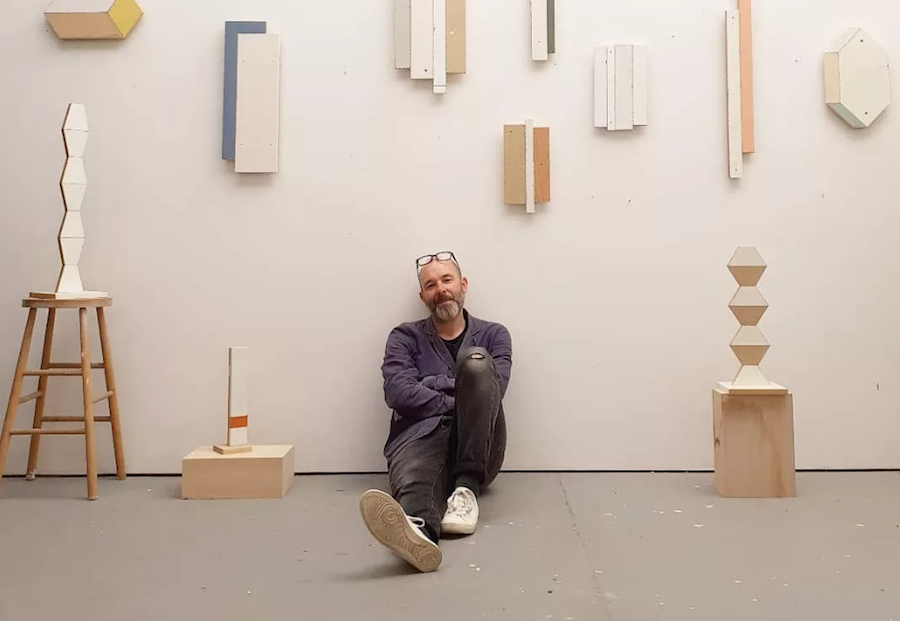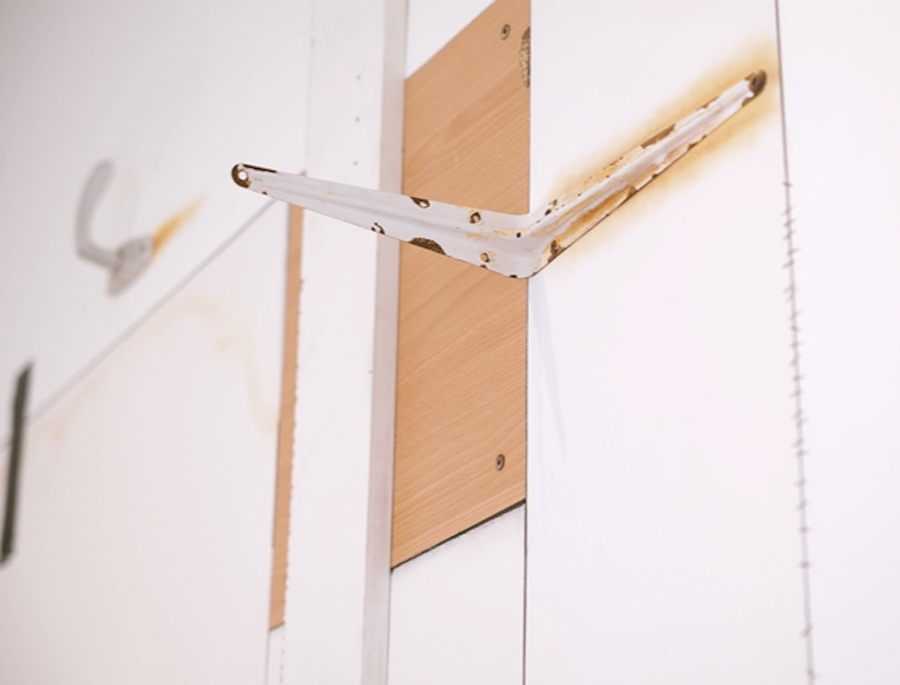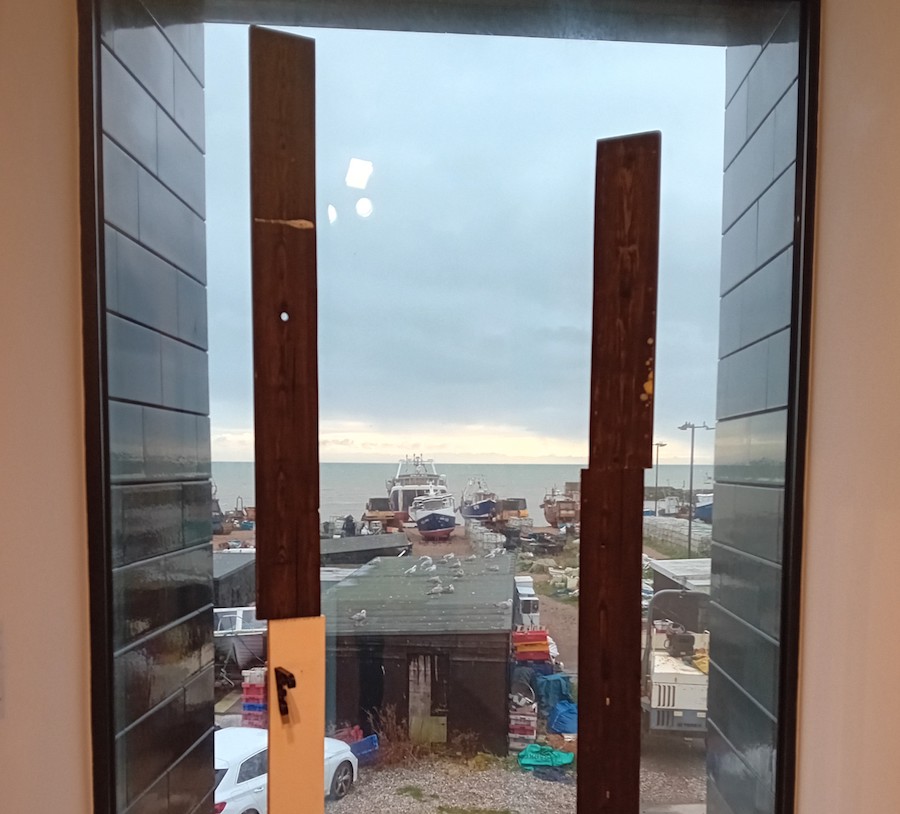In recent years Roland Hicks has used gouache, paper and coloured pencil to refashion and scrupulously reproduce the texture of plywood and Oriented Strand Board (OSB), so that first we are deceived, and then surprised by such an investment of time and effort in what look like discarded offcuts. He sees them as ‘trompe l’oeil still life paintings of fictional artworks’. It’s only at the level of finely graduated detail that we can tell what has been done. In 2021 he won the biennial Evelyn Williams Drawing Award, which sponsors the making of an exhibition at Hastings Contemporary. For that, Hicks has expanded his approach to make a site-specific installation. Two whole sea-facing walls are covered with a patchwork of apparently found materials – ‘The Fourth Wall I’ and ‘The Fourth Wall II’ – while the interstitial window with a sea view hosts two of three ‘Guardians of the Fourth Wall’, sculptures picking up on the materials used to construct the famous fishermen’s huts nearby.

Roland Hicks in the studio with previous works, photo by Laura Wright
How long did the show take to make?
I tried it all out on a wall in my studio beforehand, using the same sort of methods, so I knew the work in theory – but there were two walls in Hastings, both bigger. So most of it had to be done on site over five weeks. I had a couple of weeks before the opening to make one wall, pretty much according to my plans. Then after the show opened, I made the second wall in public, so visitors could watch me. For that, I was happy to let things happen. People engaged very actively, and most were delighted when they found out how the illusion worked. Several came back to track my progress or bring their friends. The Fourth Wall refers both to the literal description of the number of walls in each room, as well as the theatrical tradition of breaking the illusionary fourth wall between a stage and an audience, so I was both building and breaking the fourth wall simultaneously.

Do you think ‘The Fourth Wall’ looks like art – given that you wouldn’t normally expect to find such a mixture of objects?
I’d probably say my separate smaller works tend to look more like art because they’re presented in isolation on the wall in the usual way. I’m interested in at what point something starts to look like an artwork, and what is deliberate and what is accidental in that. Because it covers the whole wall, there’s a suggestion that ‘The Fourth Wall’ might not have another wall behind it, so it weakens the fabric of the building and makes it look shoddy. I started by imagining a fictional creator who wasn’t me – the potential non-art backstory is that these were things that had been found in skips, perhaps, and brought together by a collector here for reasons open to interpretation. There’s more than a hint of folly about both the real and imaginary versions of the wall’s creation.
How have you responded to the site?
There are connotations of sea defence because of the location – the sea could come in. One of the ‘doors’ is the same as one in the gallery itself, so the work refers directly to where it is, as do the ‘Guardians’.

Detail from ‘The Fourth Wall’
You’ve mixed the ‘real’ and the ‘illusionary’?
Yes, it’s the first time I have allowed myself to use real items. That sets up the question of what is real and what isn’t. There are, for example, real door handles. But all the tape and rust effects are illusionary. The rust was very much informed by spending time in Hastings, where the sea air makes any metal rust, and stains the buildings. I found a way to recreate that with chalk pastel. That’s an ageing effect, though, of course, it isn’t old. And the whole arrangement isn’t meant to look as if it’s been there very long, more as if it’s been made from elements which have been thrown out from elsewhere. There’s a suggestion it isn’t finished, as where there’s an unused reel of (unreal) gaffer tape…
Is that a moth towards the top?
I did that because a real moth landed on my studio mock-up, and at first, I thought ‘Hang on, what’s that?’ Then I thought: ‘I didn’t do that, but I really should’ – and so I did!
Is your main purpose to make us wonder what is real?
All illusionistic art involves some kind of deception, and I’m interested in how these walls are effectively built from misinformation and misdirection. But the guessing game of trompe l’oeil can fizzle out once you’ve got it. So I try to find a balance by keeping other questions open.
What are those other questions?
I like to play with the degree of spontaneity, to take something that looks as if it’s been put together quite quickly, then slow it down so it takes a long time to recreate it. I’m also interested in the point at which the art happens, in confusing that moment. In a way it messes around with time, so that a fast creative thing and a slow creative thing happen at the same time. Time becomes elastic – you’re not quite sure where the moment of creativity is located. That leads to the question of how much aesthetic decision-making is intentional – what if you make the considered look accidental? Interesting things happen when you roll those two things up against each other.

‘Guardians of the Fourth Wall’ (Detail)
Might we also read the work politically?
Certainly, building walls at a border location brings in possible issues around migration or climate change. Or it could be shoring up a cultural institution against hostile opinions. The apparent poverty of materials used and precarious, the makeshift appearance of the work could be read as a metaphor for other kinds of social fragility.
Do the whole walls also operate as abstract paintings?
I aim to find a balance between an abstract painting and an accidental cobbled-together thing, without settling too clearly on either side. If it starts to become too knowing a reference to a particular type of abstraction, I’ll try to pull it back a bit. There are hints of Piet Mondrian, or Victor Pasmore – whose 2020 retrospective was the first show I saw at Hastings Contemporary. That’s hard to avoid in presenting constructive geometric elements. The other echo is of how Kurt Schwitters incorporated what look like found bits of stuff into his Merzbau. In 2017 I curated a show in the Lake District at his Elterwater Merz Barn (1947-8).
Did your curation pick up themes present in your own work?
Yes, that was titled ‘Humble as Hell’, and included some work which you might think is just an insignificant thing with no artist behind it. Is such work a humble and Zen-like contemplation of everyday ephemera, negating the artist’s ego? Or does it take a rampant ego to think it can transform bits of rubbish into creative gold? My works are probably a bit of both in some ways.

Detail from ‘The Fourth Wall’
How do you relate to the notion of truth?
I’d say I have a committed but slippery relationship with the truth. I curated a show called ‘The Tiresome Truth’ (at ASC Gallery, London in 2019). That asked whether there is more honesty in allowing materials to just be themselves than in simulating them faithfully – does the deception in that rule out the truth? Picasso said that ‘art is a lie that makes us realise truth’.
But ‘truth versus fiction/realism versus deception’ is just one of several points of balance in your works.
Yes, you can also ask if they’re painting or sculpture, still life or abstraction, accidental or deliberate, fast or slow, playful or serious, ugly or beautiful, old or new…
Roland Hicks: ‘The Fourth Wall’ runs to 3 March at Hastings Contemporary. Hicks will be in conversation at the gallery with Graham Crowley, winner of the 2023 John Moores Painting Prize, on 2 Feb.
Top Photo: P C Robinson © Artlyst 2024

